U.S. Department of Transportation
Federal Highway Administration
1200 New Jersey Avenue, SE
Washington, DC 20590
202-366-4000
| < Previous | Table of Contents | Next > |
This section highlights the noteworthy practices identified during this assessment and documents them in the form of case studies. The case studies address challenges identified by the questionnaire, including limited access to local road data, limited agency resources, and lack of understanding of the Federal-aid process. The intent of sharing these practices is to provide various strategies and scenarios used to raise awareness of solutions to local road safety issues. The case studies describe how State DOTs and local agencies identify, develop, and implement local road safety improvement projects. They provide a cross section of local road safety practices used by States in various geographic regions, with different organizational approaches to road safety programs. The following case studies are included:
Additional local road safety noteworthy practices can be found in the documents referenced in Appendix B.
Fifty percent of California's HSIP funds are dedicated to local roads. The approximately $100 million-per-year program is managed by the Caltrans Division of Local Assistance (DLA), which is responsible for programming the funds to local road safety projects. As a part of the process, DLA sets criteria for HSIP project applications, reviews applications for accuracy, and selects projects. The division does not identify the projects for the local jurisdictions or administer the projects once selected, but instead provides guidance, tools, and training so the local jurisdictions are empowered to make informed decisions on effective safety improvements.
When the HSIP program first started, the application process was very basic, but has evolved into a data-driven process. To improve Caltrans's overall data-driven approach to statewide safety project selection and to maximize the long-term safety improvements across California, DLA developed Local Roadway Safety: A Manual for California's Local Road Owners. The manual provides an easy-to-use, straightforward, comprehensive framework of the steps and analysis tools local jurisdictions would need to proactively identify locations with roadway safety issues and the appropriate countermeasures. The manual is not intended to be a comprehensive guide for roadway design or the only guide local agencies utilize for safety analysis. The intended audience is both novice and experienced practitioners hoping to position their local agencies to better compete in future Caltrans calls-for-safety projects.
The Local Road Safety Manual benefits Caltrans and its local agencies in a number of ways. The local agencies better understand the safety program application process, the project identification and analysis steps, and the evaluation criteria Caltrans uses to rank and prioritize projects.
One of the most beneficial aspects of DLA's new data-driven process and the Local Roadway Safety Manual is the benefit/?cost (B/C) ratio. The Caltrans' HSIP project application requires applicants to calculate a benefit/?cost ratio for proposed improvements. This ratio is the foundation of the statewide project selection process. The manual outlines the methodology for calculating a benefit/?cost ratio for a potential project, including sources for estimating projected costs and benefits and the specific values/?formulas Caltrans uses for its statewide evaluations of HSIP projects. The manual also discusses the potential value in reevaluating projects' overall cost-effectiveness at this point in the safety analysis, including refining the project's costs and/or changing the mix of countermeasures and locations. For benefit/?cost analysis of HSIP projects, local agencies are required to use the Transportation Injury Mapping System (TIMS) B/C Calculator and web tools made available by Caltrans through a contract with the Safe Transportation Research and Education Center (SafeTREC) at the University of California, Berkeley (UCB). Figure 4.1 is a screen shot of the TIMS B/C Calculator.
Figure 4.1 TIMS B/C Calculator
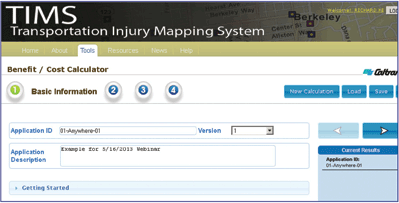
Source: Caltrans Division of Local Assistance.
DLA works in coordination with FHWA to deliver webinars to the locals on the project application process, proven countermeasures, the latest research and trends, Federal initiatives, and local case studies. On a recent webinar, approximately 200 local jurisdictions participated. The webinars also are recorded and available on-line for future reference.
Developing this resource has improved local agencies' ability to perform benefit/?cost calculations for project applications. Two-and-a-half years ago, the average benefit/?cost ratio on a project was approximately 8, but currently it is approximately 13.5. Local agencies are submitting applications for projects with greater life saving benefits. Local agencies understand the necessity of the data-driven process. The division also has seen an increase in positive communication with local agencies.
Local roadway agencies need a method for obtaining the data necessary to justify funding requests for road safety improvement projects. The Ohio Department of Transportation (ODOT) developed a crash-mapping tool called GCAT (GIS Crash Analysis Tool), which is used to map the crashes occurring on the State's roadways (Figure 4.2). GCAT uses Geographic Information Systems (GIS) to produce spatially located (latitude/?longitude) data. Crash data for all local roadways is available.
Figure 4.2 GCAT Crash Data Map
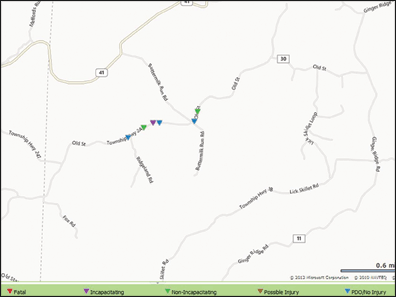
Source: Ohio Department of Transportation.
The tool is a web application and can be accessed from any computer on-line through the ODOT web site. Access to GCAT is free and easy to obtain for employees of the city, county, village, township, metropolitan planning organizations, law enforcement, and prequalified safety study consultants. Local agencies can submit a basic account request on-line and begin using the GCAT program once they are notified via email.
Users can then view various attributes such as crash type, crash severity (i.e., fatality, incapacitating injury, property damage only), etc. GCAT includes the Crash Analysis Module (CAM) Tool, which is an Excel spreadsheet tool that allows users to import the crash data. The CAM Tool analyzes the data and develops standard crash trend charts and graphs. This analysis tool was created within ODOT and allows even the casual data user to analyze crash trends quickly and easily.
Ohio LTAP offers half-day GCAT and CAM Tool training sessions to local agencies at no cost. Training sessions are held in a computer training room to allow hands-on use of the GCAT and CAM Tool software. The GCAT and CAM Tools remove the common barrier to local roadway safety data. The tools also help local agencies identify safety problems and develop potential safety improvement project applications.
ODOT has seen an increase in project applications from local agencies as tools and training opportunities provide the means to justify safety problems and identify potential countermeasures.
The Ohio Local Road Safety Program is a three-part collaboration among Ohio DOT, the Ohio LTAP center, and the County Engineers Association of Ohio (CEAO). The collaboration provides funding for local road safety improvements, offers training and technical assistance to local agencies, and assists with the administration of local safety projects.
Ohio DOT dedicates $12 million of HSIP funds annually to qualifying safety projects on county roads. The funds are administered by CEAO. ODOT also funds a position at CEAO to administer the county safety projects and provide technical assistance to counties as they develop and implement local safety projects. Once projects are approved for safety funding, they are administered by ODOT through the district offices or by local governments through the Office of Local Programs. The funding set aside specifically for county roads has enabled county engineers to take the lead in determining the improvement projects to fund. Providing funding for a CEAO position enables counties to administer projects with the assistance of the CEAO Program Manager.
Local agencies also are eligible to apply for HSIP funds through the statewide program managed by ODOT. Multidisciplinary committees review applications each year and award funds based on scored criteria and other factors, such as cost, compatibility between countermeasures and crash patterns, and relevance to the SHSP. ODOT provides crash data and user-friendly tools to help local governments analyze safety challenges and justify public investments. Section 4.2 provides additional details on the crash data analysis tools provided by ODOT.
Ohio LTAP has developed educational, outreach, and RSA programs designed to build safety knowledge at the local level. Participation in RSA programs and training has increased now that an incentive is tied to local agency RSA participation. Typically ODOT will fund low-cost safety improvements on corridors or at spot locations where RSAs are conducted; however, if an RSA identifies the need for larger, more costly improvements, ODOT sends task order consultants to assess the problem and the costs.
Ohio LTAP has used a variety of methods to educate local agencies on the Federal-aid process. LTAP is developing a series of on-line training modules based on the Locally Administered Transportation Projects (LATP) manual in order to certify local governments on their knowledge of the Federal-aid process. LTAP also has worked to provide critical but costly transportation resources to the local community as they are developed, at no cost. An example is the provision of a copy of the Highway Safety Manual (HSM) to each County Engineer's Office in Ohio and a segment of the largest City Engineer's Offices (funded through a grant to LTAP from Ohio's Office of Criminal Justice Services, formally the Ohio Governor's Highway Safety Office).
LTAP also has developed a Safety Distinction Recognition for its Roads Scholar Program. The Roads Scholar Program recognizes local practitioners that complete approved LTAP workshops/?courses relating to core subjects in transportation and public works. Graduates of the Roads Scholar Program have the option of achieving a Safety Distinction by attending safety-related courses. This additional distinction aims to emphasize the tremendous importance of safety as a primary consideration when managing and maintaining roadways and transportation infrastructure. LTAP also provides HSM and roadway departure countermeasure training courses.
The Circuit Rider Training Program provides free on-site training to local agencies upon request on various safety topics. Circuit Rider instructors travel to local agency facilities to teach introductory classes (two to three hours) that provide an overview of basic concepts such as Road Safety for Everyone, Work Zone Safety, or Snow and Ice Control.
Ohio's First Annual Local Road Safety Conference was held May 8, 2013 and sponsored by the Ohio LTAP Center and an Accelerating Safety Activities Program (ASAP) Grant from FHWA. The conference provided local agencies information on improving the safety of their local roads, including low-cost safety improvements, the new nine proven safety countermeasures, and how to make systematic safety improvements to roadways.
ODOT's partnerships with LTAP and CEAO have successfully made safety a local priority. With over 2,300 local agencies in Ohio, about 75 percent of these governments have taken advantage of the training, technical assistance, and tools provided by ODOT, Ohio LTAP, and CEAO.
Louisiana DOTD established a Local Roads Safety Program in 2006 and despite early barriers and challenges, it has become a viable program aimed at improving highway safety on Louisiana's local road network. Today, the Louisiana LTAP Center administers the Local Road Safety Program and DOTD sets aside $3 to $5 million from its Section 154/?164 Safety Transfer funds (MAP-21 continues two penalty transfer programs to encourage States to enact Open Container laws (Section 154) and Repeat Intoxicated Driver laws (Section 164). Any State that does not enact and enforce a conforming open container and repeat intoxicated driver law will be subject to a penalty transfer of funds. Additional information is available on the MAP-21 Guidance page.), HSIP funds, and HRRRP funds for local safety projects. Thanks to the successful partnership between LTAP and DOTD, technical assistance and funding is available to help local agencies implement infrastructure projects.
Within DOTD, no unit or department is responsible for administering local road safety projects, which is one of the main reasons for the partnership with LTAP. The LADOTD Office of Safety provides funding to LA LTAP for a full-time traffic safety engineer/?program manager, a part-time project engineer and two part-time traffic safety engineers. The full-time engineer/?program manager is an LTAP employee while the part-time engineers are on contract. The LADOTD Office of Safety also pays a portion of the LTAP director's salary and a portion of administrative costs. LTAP has been working with the Louisiana Highway Safety Research Group (LHSRG) which is a separate entity at LSU to access more crash data assistance. The LHSRG has been working on crash data locations on the local roads as well as developing analytical tools for use by LTAP and the locals in the future. LTAP administers the safety improvement project funds through an annual solicitation process as well as a statewide analysis to identify locations for improvement as part of the State's SHSP Intersection and Roadway Departure Action Plans. LTAP utilizes a standing committee to assist in selecting projects for funding. DOTD safety staff, FHWA, and local representatives are active participants.
The main component of the Louisiana LTAP program is to help local agencies develop the capability to solve local road safety problems using local resources or by accessing funds through the SHSP process. LTAP assists local agencies to identify, apply for, and administer local road infrastructure safety projects. Most recently, they have begun to assist the regional transportation safety coalitions with the identification and implementation of infrastructure improvements.
In 2011, DOTD divided the State into 10 regions and charged each with developing a regional safety coalition and a safety plan (a regional SHSP) to help with the implementation of the Louisiana SHSP. Each coalition reviews regional crash data to identify strategies and projects to reduce fatalities and serious injuries for impaired drivers, unbelted drivers, young drivers, and infrastructure-related crashes. LTAP works with the coalitions to identify and implement local infrastructure improvements for the plans in coordination with activities on the State system. To assist, LTAP analyzes the available crash data on the local system and presents the information to coalition members in an easy-to-understand presentation so they can discuss safety concerns and opportunities on a regional basis. Figure 4.3 is a slide developed by LTAP for a regional safety coalition meeting for the discussion. The purpose of the discussion is to help participants begin the process to identify and prioritize road segments and intersections for further analysis. Once participants agree on their priorities, RSAs are conducted at the selected sites so solutions can be developed.
Figure 4.3 LA LTAP Slide Developed for Regional Safety Coalition
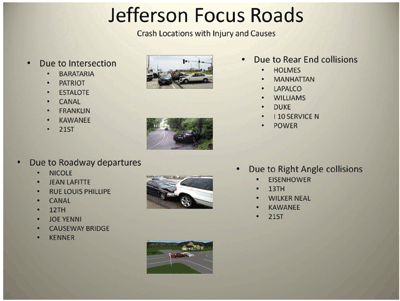
Source: Louisiana LTAP.
The regional coalitions can then apply for funding from LTAP for the improvements identified during the RSAs. Typical project types include sign improvements, geometric improvements, and other low-cost safety improvements.
To date, LTAP has provided local data, data analysis, and technical assistance to four regional coalitions. The most advanced coalition, the South Central Regional Transportation Safety Partnership, has conducted five RSAs, and with the help of LTAP is preparing to apply for funding. Figure 4.4 shows an LTAP representative leading an RSA for the South Central Regional Safety Coalition. LTAP also currently is working with coalition members (as well as individual parishes) to implement a systemwide/?systemic approach to improving safety on horizontal curves. LTAP has located all horizontal curves on the local road system. LTAP is working with the local agencies and DOTD to develop a process to characterize and prioritize these curves based on certain criteria and to develop a manageable process to implement projects systemically.
Figure 4.4 LTAP Led RSA for the South Central Transportation Safety Coalition
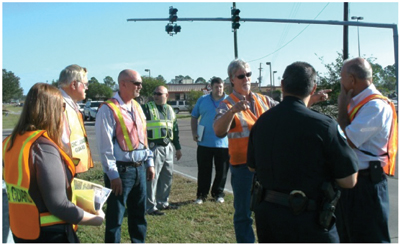
Source: South Central Planning and Development Commission.
In terms of next steps, LTAP, LSU, and DOTD are partnering on a three-year program to assemble roadway and traffic data on the local road system. This program will collect roadway characteristic and traffic data on all arterials, collectors and roads of significance for the local road system. This will continue to enhance LTAP's capability to work with the local agencies, share data, and collaborate on infrastructure improvements. LTAP is facilitating the development of a research project to develop better estimates of local road AADT which is necessary for many of the analytical tools currently being used to analyze for safety.
The Florida DOT District 7 Local Safety Program is a comprehensive district-level local road safety program. Florida DOT District 7 covers Hillsborough, Pasco, Pinellas, Citrus, and Hernando counties. Major cities in the district include Tampa, Clearwater, and St. Petersburg.
The District 7 Local Safety Program began in 2011 when the district safety engineer was asked to identify strategies to improve traffic safety in the district. At the time, a disproportionate number of fatalities occurred on locally owned roadways. While a number of safety initiatives had been implemented on State-maintained roadways, safety continued to be a concern for the district. The safety engineer began exploring methods for reducing fatalities on local roadways. At the same time, many local jurisdictions were dealing with reduced budgets and did not have additional resources to address the growing problem. The district safety engineer sought the DOT district management's support to allocate a greater portion of the District's HSIP funds to local safety improvements.
The local agencies needed guidance and assistance navigating the Federal-aid process. District 7 held the first annual local agency safety summit in 2011. The purpose of the annual summit is to provide the department and local agency management-level staff with key information on the traffic safety issues specific to the Tampa Bay region. The summit also briefs local agency partners on current efforts and strategies to reduce crashes throughout the region, with a primary focus on Florida's commitment to dedicate State and Federal safety funds to local agency projects as a part of the HSIP. A timeline to submit applications for the district program is provided to local agencies, including the application deadline and a summary of the three phases of the process. The project timeline is available at the District 7 Safety Timeline web page.
At the end of the summit, the intent is to reach a consensus relative to enhancing the transportation safety partnership between FDOT and local agencies. For more information go to the District 7 Safety Summit web page.
After the first summit in 2011, the district safety engineer and staff were overwhelmed with requests for information and guidance as local agencies navigated the process. To better accommodate the local agencies' inquiries, Safety Ambassadors were hired through consultant support to help local agencies through the process. The safety ambassadors provided engineering-related support and guidance and helped the locals understand how they could apply for Federal safety funds to improve local road safety. In addition, consultant support developed the Local Agency Safety Funding Guide for Off-System Roadways to assist the District 7 local agencies in applying for HSIP funds for safety projects.
Local agencies must be Local Agency Program (LAP) certified to contract with FDOT and be reimbursed for projects using Federal-aid funds. LAP experts assist local agencies with navigating the certification process. District 7 employed a LAP expert to support local agencies applying for HSIP funds through the local safety program. Providing LAP support allows the safety ambassadors to focus on engineering and technical support to local agencies. The District 7 Safety Program provides technical assistance, training, and support to local agencies in a variety of ways. The program provides district-wide manpower support to local agencies for RSAs, in-house support for engineering issues, and design support for approved off-system safety projects. The program also provides signs and other items needed to improve safety to local agencies for installation by local labor forces. This option allows local agencies to avoid the administrative work of applying for funds to pay for the materials if their local forces can install the materials. The materials program requires local agencies to sign an agreement to install and maintain the materials provided.
The District 7 Safety Program also developed a design-build push-button (DBPB) contracting vehicle to streamline the process for specific local safety improvements. The DBPB process uses Federal safety funds to issue multiple safety projects during a contract period shortening the contract execution process. The DBPB is summarized as a separate case study in Section 4.6. The District 7 Local Agency Safety Funding Guide is a comprehensive resource guide for the District's safety programs.
The District 7 Local Safety Program has been the catalyst for an increased emphasis on safety in the district. The program has supported the following traffic safety initiatives:
Bringing greater awareness to the District's traffic safety issues has been a catalyst for local elected officials to support traffic safety improvements. In addition to the safety improvements made through the District's program, several local agencies have obligated funds from their own budgets to support safety improvements. Hillsborough County and the City of Tampa have spent nearly $10 million on bicycle and pedestrian safety improvements. Due to the program's success, Florida DOT is looking at strategies to replicate the District 7 program in other districts around the State.
The Nebraska Department of Roads (NDOR) Local Projects Division and Nebraska LTAP Center provide a systemic county sign installation program. Many of Nebraska's 93 counties do not have a county engineer. The program started because the State was receiving few HRRRP project applications. To encourage participation from local agencies, NDOR conducts a systemic safety analysis to identify potential sites (e.g., horizontal curves) for safety improvements based on risk. To market the program, the NDOR takes advantage of the Nebraska LTAP Center's contacts at local agencies throughout the State. The LTAP Center meets with the county superintendents and city supervisors and provides crash data and information about the project application process. Project site locations are selected by the counties. Counties agree to install signs according to the requirements of the Nebraska MUTCD. The Nebraska LTAP Center conducts spot checks to ensure proper installations.
The program has helped Nebraska successfully obligate safety funds, especially the HRRRP. The program has received participation from 78 of Nebraska's 93 counties.
The Ohio DOT's Office of Local Programs, with the assistance of the Ohio LTAP Center, administers a systemic signage intersection and curve upgrade program for targeted Ohio Townships. The program provides two opportunities for townships to apply for free safety and advanced warning signs.
As a part of the program, the Ohio LTAP Center provides crash data and information on the types of sign packages available for specific situations. Townships can choose from the signage packages or build their own sign orders. The signage packages help insure the townships install the signs according to the requirements of the Ohio Manual of Uniform Traffic Control Devices (OMUTCD). The ODOT Office of Local Programs also provides guidance and assistance to Townships on sign installation if necessary. Program details are available on the ODOT Local Programs web page. Figure 4.5 shows before and after photos for a sign installation completed as a part of the program.
Figure 4.5 Before and After Photos of Sign Installation
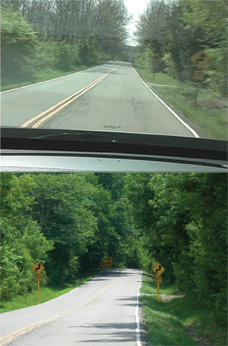
Source: Ohio Department of Transportation/LTAP.
The Tennessee DOT Local Roads Safety Initiative (LRSI) was created in 2010 to assist with improving safety on local roads. TDOT created the initiative to assist its counties with road safety improvements. The initiative provides basic signing, striping upgrades, signage for curves, guardrail, and approaches to guard rails. Most counties have limited support staff and very few counties have staff with the needed engineering expertise. Only 6 of 95 county chief administrative officers are licensed engineers. The LRSI was developed by a partnership between the SHSP and safety projects coordinator, State traffic engineer, assistant chief of operations, incident management division director, and the Tennessee FHWA Division. TDOT developed a consultant contract and hired two consultants to conduct local road safety analysis in Tennessee's 95 counties.
A list was generated by the Tennessee Department of Safety (TDOS) ranking counties not wholly located in an MPO based on serious injuries and fatalities per mile of county roads. This ranked list is used to select counties to implement improvements. The consultant requests crash data for local roads from the TDOS for the selected county. A meeting is scheduled with county officials (i.e., County Mayor, Sheriff, Road Supervisor, and emergency medical services) to explain the program and obtain their buy-in and cooperation. County officials are asked to provide their input on spot locations and corridors where they perceive the greatest need for safety improvements and provide crash reports and any other data to support their selections.
The information collected from county officials is added to the TDOS crash database for the county and the consultant develops a priority list of spots and/or corridors. The list is provided to the county for comment and concurrence. Once the list is approved a Road Safety Audit Review (RSAR) prebrief meeting is held in the county with available stakeholders to gather information on perceived problems to be reviewed by the consultant team during the field review. The final RSAR sites are reviewed and approved by the TDOT Project Manager and State Traffic Engineer.
The Tennessee LTAP and FHWA Resource Center provide RSA training for Tennessee's local agencies and counties. Field reviews consist of a minimum of three people that have completed RSAR training. The FHWA Safety Engineer and TDOT Region Traffic Engineer also are invited to attend the field review but their presence is not required. The RSAR is conducted and draft guidance and an audit package called the "no-plans audit" is produced by the consultant team. The estimated recommendations to be incorporated into a no-plans contract should not exceed $250,000. The draft audit package is submitted to the TDOT Project Manager for review by the State Traffic Engineer and Assistant Chief Engineer (Operations). The document also is available for FHWA review. After the audit package is approved, it is submitted to the Environmental Office to obtain required permits and the revised report is submitted to the county officials for comment. The use of "no-plans audits" during the RSAR documentation process allows projects with no right-of-way acquisition or utilities relocation to be expedited more quickly because the RSAR report goes directly to the environmental permits process, skips the design process, and goes to construction.
The final report is completed after the consultant conducts a post-RSAR briefing with the county stakeholders to resolve any issues with the guidance and obtain their concurrence. Once the environmental documents are received, the consultant produces no plans contract documents based on the priority sites list and estimated cost up to $250,000. The county is required to sign a maintenance agreement with TDOT agreeing to maintain the roadway upon completion of the project.
The TDOT Local Road Safety Initiative has successfully conducted RSARs through the draft stage for 45 counties and 21 projects have been let to bid and awarded since the program's inception.
The Florida DOT District 7 Safety Program developed an expedited DBPB contract process which allows local agencies to request the use of a District 7 contractor to install a variety of safety countermeasures from a preapproved list. DBPB contracts must not require the acquisition of additional or new right-of-way. Projects also must have minimal impact to utilities and drainage. Examples include:
FDOT Central Office agreed to allow District 7 to pilot test this unique contracting concept in September 2007. District 7 began working with FHWA Florida Division to gain approval to include Federal safety money under this combined contract in June 2008. After receiving FHWA's approval, the District began developing the request for proposals (RFP) and conducted an informational meeting with the consultant community and contractor industry to gain input. The RFP was released in March 2009. The contract was executed in December 2009. The first contract task, which included 11 projects, was executed in January 2010.
DBPB contracts can issue numerous tasks, covering various project types through the life of the contract (two years in this case). Tasks are issued through the DBPB contract by a predetermined process which includes a feasibility and justification study, task scopes with maximum task time and costs, task scopes review, FHWA review, and approval, and allocation of approved funds for each DBPB task. At this point, the district construction office sends the notice to proceed (NTP) to the DBPB firm and work begins. SharePoint technology is used to coordinate weekly progress meetings and share DBPB plans and tasks information.
The DBPB process saves lives, time, and money. The streamlined process enables FDOT District 7 to complete operational or safety improvements up to $1 million on a faster timeline and better meet public expectations that safety improvements are made quickly. Project timelines are reduced by at least 25 months.
An evaluation of the DBPB process estimated a 30 percent savings in design and construction engineering inspection costs. The total estimated crash reduction for the 11 projects in the first task is 138 crashes.
More information on the FDOT District 7 Local Safety Program and DBPB can be found at FDOT District 7 Safety Summit web page.
| < Previous | Table of Contents | Next > |
